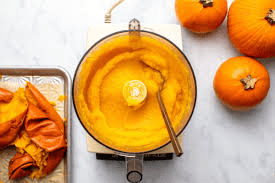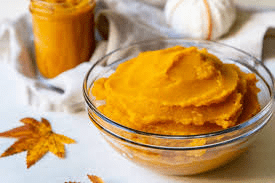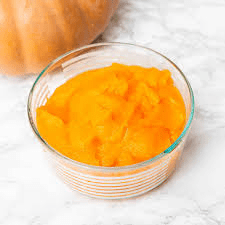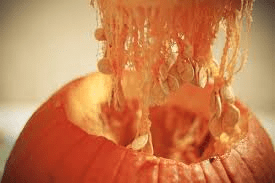Pumpkin pulp, often referred to as the stringy, fibrous material found inside a pumpkin surrounding the seeds, is a nutritious and versatile component of the pumpkin. While it is often discarded during pumpkin carving or cooking, this pulp offers a range of culinary and health benefits that make it worth saving and using in various ways.
The texture of pumpkin pulp is somewhat fibrous and moist, making it suitable for adding body and thickness to various dishes. This part of the pumpkin is packed with essential nutrients, including vitamins A, C, and E, as well as minerals like potassium and magnesium. These nutrients contribute to overall health, supporting immune function, skin health, and maintaining healthy vision.
Pumpkin pulp is especially rich in dietary fiber, which is beneficial for digestive health. Fiber helps to regulate bowel movements, prevent constipation, and maintain a healthy gut microbiome. Additionally, the pulp’s natural sugars and carbohydrates can provide a quick source of energy, making it a useful ingredient for both sweet and savory recipes.
In the kitchen, pumpkin pulp can be used in a variety of ways. One common use is in soups and stews, where the pulp adds thickness and a subtle pumpkin flavor. It can be pureed and incorporated into sauces, providing a nutritious base for dishes. Pumpkin pulp is also a great addition to baked goods, such as bread, muffins, and cookies, where it adds moisture and enhances the nutritional profile of the final product.
To prepare pumpkin pulp for cooking, it is typically scooped out of the pumpkin, along with the seeds, during the carving or cutting process. The seeds can be separated and roasted, while the pulp can be rinsed and used directly or pureed for smoother texture. When pureeing pumpkin pulp, it can be blended with a small amount of water or broth to achieve the desired consistency.
In addition to its culinary uses, pumpkin pulp has applications in natural skincare and beauty routines. Due to its high vitamin and antioxidant content, pumpkin pulp can be used as a base for homemade facial masks and scrubs. These treatments can help exfoliate the skin, reduce inflammation, and promote a healthy glow. The pulp’s natural enzymes and alpha hydroxy acids are particularly beneficial for removing dead skin cells and rejuvenating the complexion.
From an environmental perspective, using pumpkin pulp can help reduce food waste. Instead of discarding this nutritious part of the pumpkin, it can be utilized in various ways to maximize the value of the entire fruit. Composting any leftover pulp that isn’t used in cooking or skincare can also enrich garden soil, contributing to a sustainable and eco-friendly lifestyle.
For those interested in preserving pumpkin pulp for later use, it can be frozen or canned. To freeze pumpkin pulp, it should be pureed and placed in airtight containers or freezer bags. Properly stored, it can last for several months in the freezer. Canning pumpkin pulp requires following safe canning practices to prevent spoilage and ensure that the pulp retains its nutritional benefits.
Pumpkin pulp is a highly nutritious and versatile component of the pumpkin that should not be overlooked. Its rich content of vitamins, minerals, and fiber make it a valuable addition to a balanced diet, while its uses in culinary and skincare applications demonstrate its versatility. By finding creative ways to use pumpkin pulp, we can enhance our meals, improve our health, and contribute to a more sustainable lifestyle. Whether adding it to soups, baking it into treats, or using it in beauty routines, pumpkin pulp offers a wealth of benefits worth exploring.
The Economic Importance and Uses of Pumpkin Pulp

1. Food Ingredient: Pumpkin pulp is used in various culinary dishes, such as soups, pies, and breads. For example, pumpkin pie filling is made from pumpkin pulp.
2. Baby Food: The smooth texture and nutritional benefits of pumpkin pulp make it a popular ingredient in baby food.
3. Animal Feed: Leftover pumpkin pulp from processing can be used as animal feed, providing a nutritious option for livestock.
4. Dietary Supplements: Pumpkin pulp is used in supplements for its high beta-carotene content, which supports vision and immune health.
5. Cosmetic Products: Pumpkin pulp is used in skincare products for its exfoliating and nourishing properties. For example, pumpkin face masks.
6. Pet Food: Pumpkin pulp is a common ingredient in pet foods and treats, providing fiber and vitamins for pets.
7. Fertilizer: After processing, the remaining pumpkin pulp can be composted to enrich soil quality.
8. Weight Loss: Due to its high fiber and low-calorie content, pumpkin pulp is often included in weight loss diets.
9. Culinary Arts: Chefs use pumpkin pulp creatively in gourmet dishes, enhancing their menus with seasonal and innovative recipes.
10. Ethnic Cuisine: Pumpkin pulp is a traditional ingredient in many ethnic dishes around the world, such as Mexican calabaza en tacha.
11. Baking Industry: Pumpkin pulp is a key ingredient in various baked goods, such as bread, muffins, and cookies.
12. Seasonal Products: During autumn, pumpkin pulp is used extensively in seasonal products like pumpkin spice lattes, promoting seasonal sales.
13. Food Preservation: Pumpkin pulp can be canned or frozen, providing a long-lasting food source that can be utilized throughout the year.
14. Beverage Industry: Pumpkin pulp is used in beverages like pumpkin smoothies and pumpkin-flavored drinks.
15. Soups and Stews: Pumpkin pulp is a common ingredient in soups and stews, adding flavor and nutrition. For example, pumpkin soup is a staple in many cuisines.
16. Functional Foods: Pumpkin pulp is used in functional foods designed to provide health benefits beyond basic nutrition, such as improving gut health.
17. Home Cooking: Home cooks use pumpkin pulp in a variety of dishes, making it a staple in household kitchens during the fall season.
18. Juicing Industry: Pumpkin pulp is used in juicing for its nutritional benefits and unique flavor.
Read Also: What Do Bees Use Honey For
The Products and By-products That Can Be Derived From Pumpkin Pulp

1. Pumpkin Puree: Made by cooking and blending pumpkin pulp, used in soups and desserts. Example: canned pumpkin puree.
2. Pumpkin Soup: Prepared by cooking pumpkin pulp with broth and spices, often pureed. Example: creamy pumpkin soup.
3. Pumpkin Bread: Bread made with pumpkin pulp and spices. Example: pumpkin bread loaf.
4. Pumpkin Ice Cream: Ice cream made with pumpkin pulp and spices. Example: pumpkin-flavored ice cream.
5. Pumpkin Pie Filling: Prepared filling made from pumpkin pulp and spices, used in pies. Example: canned pumpkin pie filling.
6. Pumpkin Scones: Baked goods made with pumpkin pulp and spices. Example: pumpkin scones.
7. Pumpkin Smoothies: Blended drinks made with pumpkin pulp, yogurt, and spices. Example: pumpkin spice smoothie.
8. Pumpkin Lasagna: A savory dish made with layers of pumpkin pulp, pasta, and cheese. Example: pumpkin lasagna.
9. Pumpkin Curry: A spicy dish made with pumpkin pulp, spices, and coconut milk. Example: pumpkin curry.
10. Pumpkin Pickles: Pumpkin pulp pickled in vinegar and spices. Example: sweet and spicy pumpkin pickles.
11. Pumpkin Marmalade: A sweet spread made from pumpkin pulp and sugar. Example: pumpkin marmalade.
12. Pumpkin Cakes: Cakes made with pumpkin pulp and spices. Example: pumpkin bundt cake.
13. Pumpkin Pudding: A dessert made with pumpkin pulp, milk, and spices. Example: pumpkin pudding.
14. Pumpkin Enzyme Extract: Used in skincare for its exfoliating properties. Example: enzyme pumpkin facial masks.
15. Pumpkin Chips: Sliced and dehydrated or fried, served as a snack. Example: crunchy pumpkin chips.
16. Pumpkin Butter: A spread made from pumpkin pulp, spices, and sweeteners. Example: spiced pumpkin butter.
17. Pumpkin Juice: Extracted from the pulp, used as a beverage or in cooking. Example: fresh pumpkin juice.
Read Also: What Do Honey Bees Look Like
Frequently Asked Questions (FAQ’s) About Pumpkin Pulp

1. How can I make pumpkin puree at home?
To make pumpkin puree, bake or steam the pumpkin pulp until soft, then blend it until smooth.
2. Can pumpkin pulp be frozen?
Yes, pumpkin pulp can be frozen. Cut it into cubes or puree it before freezing to use later in recipes.
3. Is pumpkin pulp healthy?
Yes, pumpkin pulp is rich in vitamins A, C, and potassium, making it a healthy addition to your diet.
4. How do I cook pumpkin pulp?
Pumpkin pulp can be baked, steamed, boiled, or roasted. It can then be used in a variety of dishes.
5. What dishes can I make with pumpkin pulp?
You can make soups, pies, breads, cakes, smoothies, and more with pumpkin pulp.
6. How long does fresh pumpkin pulp last?
Fresh pumpkin pulp can last up to a week in the refrigerator. For longer storage, it can be frozen.
7. Can I eat raw pumpkin pulp?
Yes, raw pumpkin pulp can be eaten, though it is often cooked to improve its texture and flavor.
8. What is the best way to remove pumpkin pulp from the shell?
Cut the pumpkin in half, scoop out the seeds, and use a spoon or knife to remove the pulp from the shell.
9. Is there a difference between pumpkin pulp and pumpkin puree?
Yes, pumpkin pulp is the raw, uncooked part of the pumpkin, while pumpkin puree is cooked and blended pulp.
10. Can pumpkin pulp be used in savory dishes?
Yes, pumpkin pulp is versatile and can be used in both sweet and savory dishes, such as soups and curries.
Read Also: Environmental Management Tips for Sustainable Living

